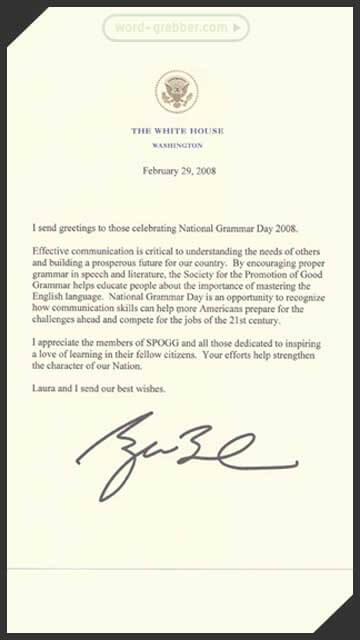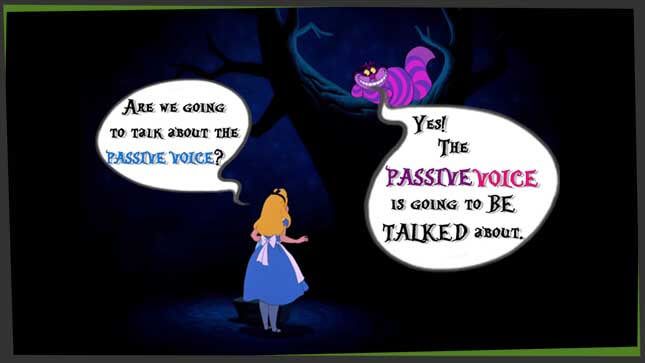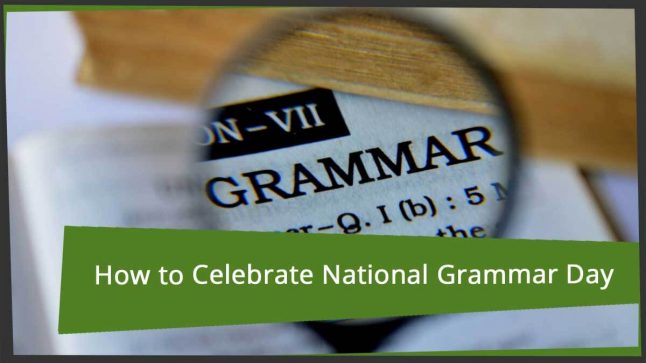National Grammar Day is a fairly recent addition to our calendars compared to most holidays. The grammatically correct day was founded in 2008 by Martha Brockenbrough. According to an interview with Grammarly, she was inspired by the high school students she taught at the time. Apparently, “they needed a bit of help with their grammar” and Martha opted to make the lesson more exciting than it usually is.
Once she realized there was no such thing as National Grammar Day, she set about creating an entire day dedicated to all things grammar. From memes to actual grammar lessons, National Grammar Day is about focusing on the English language and the many intricacies that make its “rules” so fluid.
Why Do We Need A Day About Grammar?
For those who aren’t English majors or writers of any kind, you might be wondering why anyone should bother with National Grammar Day. Well, believe it or not, grammar is vital to literally everything around you. That includes words. If no one cared about grammar, advertisements and slogans would sound very strange. The age-old McDonald’s slogan “I’m lovin’ it”, for example, would be awfully odd if we took away the punctuation or removed the conjunction. “I am loving it” simply doesn’t have the same ring to it.
If you need a more official reason, President Bush dedicated a letter to Martha and the society she founded for National Grammar Day. He spoke of the importance of language to help American citizens tackle the problems of the new century and the exciting technology that came with it.

How Can You Celebrate National Grammar Day?
Now that you know all about National Grammar Day, you might be wondering how you should be celebrating it. You can always organize events for your local community, but the day seems to be largely celebrated online. This includes the annual Limerick Contest, held entirely on Twitter.
If you are not a writer, create memes or infographics based around the grammar rules you do remember or use every day. If you happen to be a writer, however, it is highly recommended that you impart the wisdom of your experiences. National Grammar Day is the opportunity to teach aspiring writers what they can do to improve their skills.
As a fellow writer, I would like to share two of the grammatical rules I struggle with the most. After all these years, I might be an expert at hunting them down and fixing them, but that doesn’t mean they don’t crop more often than I’d like to admit.
Grammar Tips – Run-Ons and Passive Voice
No matter what you need to write, be it a technical manual, copywriting, or creative fiction, you need to know a few basic rules of grammar. Unfortunately, just knowing the English language as a native speaker is not enough. You need to learn how to keep your material engaging and informative – yes, I mean the technical manuals too.
Run-Ons Going On and On and On
Have a problem with run-ons? Heck, I know I do! There’s probably a few in this article. As someone with a chronic run-on condition, there are a few ways to maneuver your way to shorter sentences and better flow.
- If a sentence takes up more than 1.5 lines in the average 81/2 x 11 document, take a closer look at it. This is a good tip for those writers who edit as they go, but definitely don’t forget to go over your work again anyway.
- Read your article out loud. I know it’s weird to do alone in a room, or with roommates next door, but I swear hearing the sentences out loud is one of the best ways to see where you fucked up.
Stop a Run-On in Its Tracks
- More often than not, you need to divide a run-on into two or more sentences with a period.
- You can use the semi-colon, but you had better know what you’re doing. Here’s an infographic from The Oatmeal to help you.
Passive Voice – Who Is Doing What?
These are probably the hardest to detect if you’re writing in a technical manner or reporting the news. What the latter two writing styles have in common is that the writers need to convey a lot of information at once. To do so without falling into the passive voice can be very difficult.
In fact, I just did it in the last sentence. Grammar tools and your editor will pick up phrases like “can be” as passive, because it removes the action from the subject of the sentence.
Passive Voice to Active Voice – Be Aggressive
Using the sentence above, the first step is to pick out what the subject of the sentence is and what the subject is doing.
“To do so without falling into the passive voice can be very difficult.”
Subject: passive voice
Action: not falling into the passive voice
The second step is to turn the passive action into something more assertive. “Can be” is fixed simply with the more active version “it IS very difficult.” Don’t pussyfoot around it.
Another common passive voice mistake is when the sentence includes the words “to be.” If we use a sentence I had in my first draft, for example: “A run-on needs to be divided by a period.” This basically translates to: “subject needs to be actioned upon.” See how awkward that is?
Be more assertive! In this case, find out who is really doing the action, because they’re missing from your sentence. So instead of “a run-on needs to be divided by a period”, say “the writer needs to divide a run-on into two or more sentences with a period.” Now there is someone responsible for the action, it isn’t just something magical that happens on its own.

But I Need Passive Voice
You don’t, not really. I am including academic essays in that statement. Unless there is truly no one doing the action and the reader must withdraw from the text, then the passive voice is fine. Passive voice will appear in manuals and instructional documents whether we like it or not. If you want to keep your reader engaged, stay far away from passive voice and make sure you’re double-checking your work.
Free Grammar Checks for All
If you’re too lazy to read over your work yourself, this grammar check is extremely useful and free. Not only does it tell you far more than tools like Grammarly can for free, it will also tell you what it is you’re doing wrong. This checker includes example sentences and definitions for your convenience, but not how to straight up fix it. If you don’t manage by re-wording it, a little research might be necessary.
Happy National Grammar Day!
title – Grammar – by getstencil for word-grabber.com
picture 1 – letter from bush – via https://www.quickanddirtytips.com/images/ngd/bush-letter.jpg for word-grabber.com
picture 2 – meme of Alice in Wonderland – via https://3.bp.blogspot.com/-ZvVwiEnMPFk/WbxexbeGEaI/AAAAAAAACgc/tQKFsEWY4ywXg4hrmmrSAIBYVMTRWIIzwCLcBGAs/s1600/Wonderland-disneyscreencaps.com-6558.jpg for word-grabber.com

